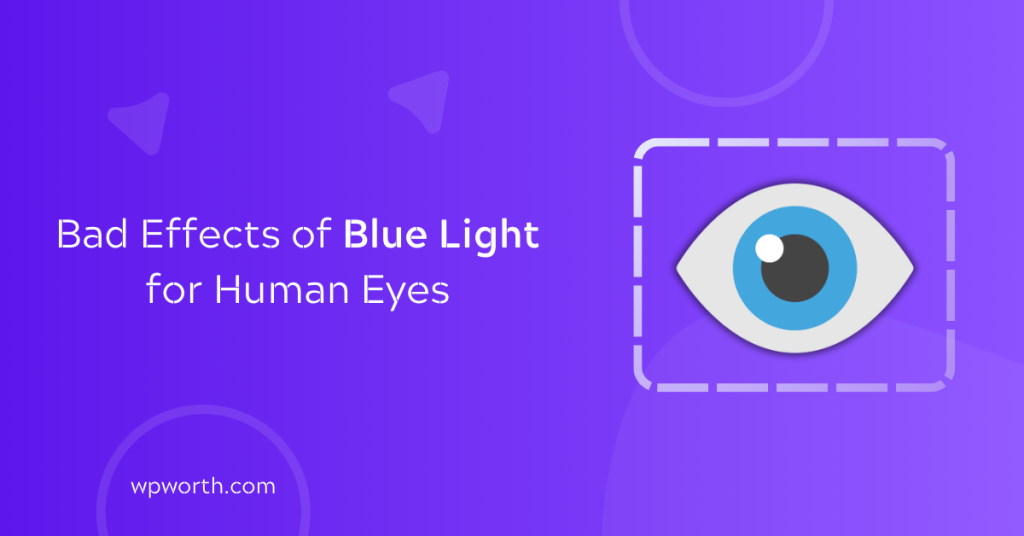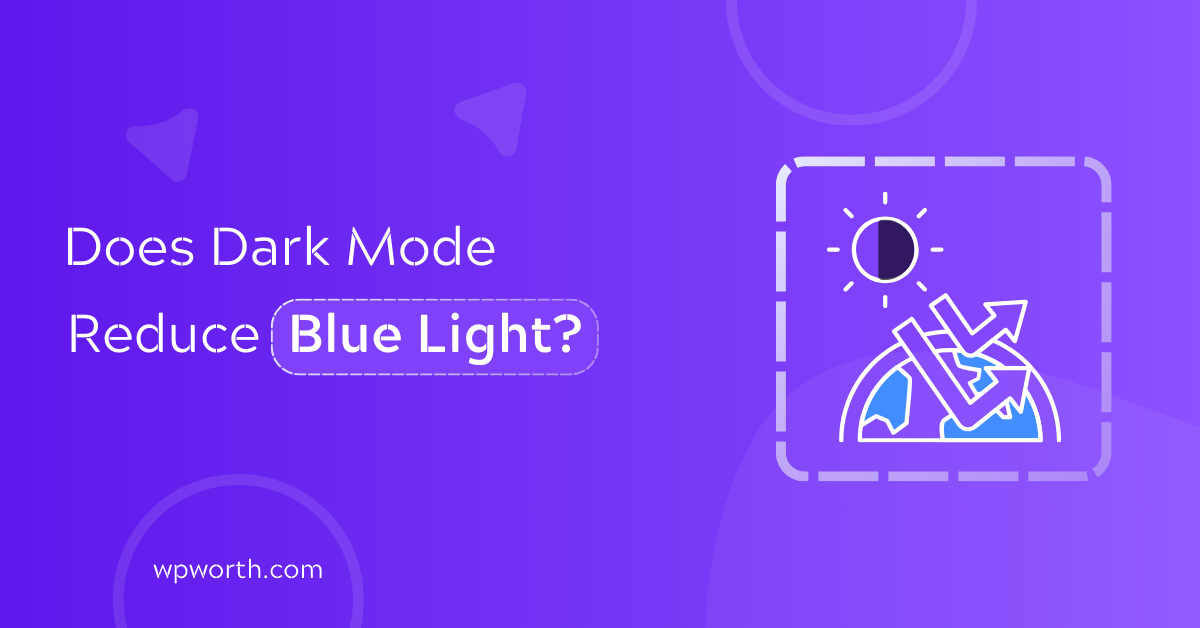It’s late at night, and you’re scrolling through your smart device, feeling your eyes growing tired from the long day.
As you stare at the bright glow of your screen, you start to wonder—could this harsh blue light be affecting your sleep?
Research shows that blue light from screens can interfere with your circadian rhythm, making it harder to fall asleep. In fact, studies suggest that exposure to blue light at night can decrease your sleep quality by up to 60%.
That’s where dark mode comes in. It’s a feature many people swear by, offering a more comfortable, less glaring screen experience.
But does switching to dark mode actually reduce blue light exposure?
The answer isn’t as simple as you might think. Let’s take a closer look at whether dark mode truly helps.
What is Blue Light?
Blue light is a high-energy, short-wavelength light that falls within the visible light spectrum, which is the range of light that humans can see.
This type of light has wavelengths between 380 and 500 nanometers, making it more energetic and potentially more harmful than other types of visible light.
While it’s naturally present in sunlight, blue light is also emitted by digital screens—smartphones, laptops, tablets, and TVs—as well as artificial lighting, like LED and fluorescent bulbs.
In fact, research shows that our daily exposure to artificial blue light has increased by 60% over the past decade due to the widespread use of digital devices.
Is Blue Light Bad for Your Eyes?
Blue light has sparked a lot of debate when it comes to its effects on eye health. While some exposure is necessary for regulating our sleep cycle, too much blue light, especially from digital screens, can lead to eye strain and discomfort.
This condition, known as “digital eye strain” or “computer vision syndrome,” causes symptoms like dry eyes, blurry vision, headaches, and neck or shoulder pain.
Although there’s no solid evidence that blue light causes permanent damage or leads to conditions like macular degeneration, prolonged exposure could potentially have long-term effects, as blue light penetrates deeper into the eye.
To reduce discomfort, experts recommend following the 20-20-20 rule—every 20 minutes, look at something 20 feet away for 20 seconds—and using blue light filters or screen protectors to minimize exposure.
Bad Effects of Blue Light for Human Eyes

Blue light might seem harmless, but too much of it can have hidden consequences for your eyes. Here are some of the not-so-great effects of blue light exposure:
- Eye Strain and Fatigue: Prolonged exposure to blue light can cause digital eye strain, leading to discomfort, dry eyes, and tiredness. Your eyes work harder to focus, which can result in fatigue.
- Disrupted Sleep Patterns: Blue light exposure, especially at night, interferes with melatonin production, making it harder to fall asleep and affecting your overall sleep quality.
- Potential Retinal Damage: While research is ongoing, some studies suggest that blue light might penetrate deeper into the eye and could contribute to retinal damage over time.
- Headaches and Migraines: Staring at screens for extended periods can trigger headaches or migraines, especially for those sensitive to light.
- Increased Risk of Macular Degeneration: There’s concern that long-term exposure to high levels of blue light may increase the risk of macular degeneration, a leading cause of vision loss, although more research is needed.
Does Dark Mode Mode Really Reduce Blue Light?
The idea of dark mode reducing blue light exposure is popular, but the answer isn’t entirely straightforward. While dark mode can make the screen less bright and reduce overall glare, it doesn’t directly block blue light.
The primary function of dark mode is to change the background color of the screen from light to dark, making it easier on the eyes, especially in low-light settings.
However, blue light still exists in dark mode, though it may be less noticeable due to the reduced screen brightness. In fact, studies suggest that dark mode doesn’t significantly reduce blue light emissions compared to light mode.
To truly limit blue light exposure, you’d need to use a blue light filter or enable built-in features on your device specifically designed to reduce blue light, like “Night Shift” on Apple devices or “Night Mode” on Android.
Best Ways to Get Rid of Blue Light Exposure

Reducing blue light exposure can help protect your eyes and improve your sleep quality. Here are some of the most effective methods:
1. Dark Mode
Switching to dark mode reduces screen brightness, making the display easier on your eyes, especially in low-light settings. While it doesn’t directly block blue light, it can help reduce glare and minimize eye strain. Many websites, apps, and devices now support dark mode, making it easier to enable across different platforms.
- Browser Extensions for dark mode
- WordPress dark mode plugins for enabling dark mode
- Built-in dark mode settings on smart devices
- System-wide dark mode settings on computers
2. Blue Light Filters
Many devices now come with built-in blue light filters or Night Shift modes, which adjust the color temperature of the screen to warmer tones. This reduces the intensity of blue light emitted and helps prevent eye strain, especially in the evening. You can also use third-party apps or physical screen protectors to filter out blue light.
3. Blue Light Blocking Glasses
Blue light blocking glasses are designed with special lenses that filter out blue light, protecting your eyes from potential strain. These glasses can be particularly helpful for people who spend long hours in front of digital screens, providing relief from digital eye strain and improving sleep quality.
4. Adjust Screen Settings
Many devices allow you to manually adjust the color temperature and brightness. Reducing the brightness of your screen or using warmer colors can help minimize blue light exposure, especially in the evening.
5. Take Regular Breaks (20-20-20 Rule)
The 20-20-20 rule helps reduce eye strain: every 20 minutes, look at something 20 feet away for at least 20 seconds. This gives your eyes a break from focusing on the screen and reduces the risk of digital eye strain.
6. Control Ambient Lighting
Make sure your workspace is well-lit with warm, soft lighting. Avoid using overhead fluorescent lights or overly bright lighting, as this can increase glare and worsen eye strain. Proper lighting helps balance screen brightness and reduces the contrast between the screen and your surroundings.
Dark Mode vs Blue Light Filter vs Blue Light Glasses
There are several ways to reduce blue light exposure, and among the most popular options are dark mode, blue light filters, and blue light glasses.
Each of these methods offers unique benefits, but they work in different ways to protect your eyes and improve your overall digital experience. To help you choose the best option, let’s compare them based on different aspects.
| Aspect | Dark Mode | Blue Light Filter | Blue Light Glasses |
|---|---|---|---|
| Purpose | Reduces screen brightness and glare | Filters out blue light wavelengths | Blocks blue light directly from reaching the eyes |
| Effect on Blue Light | Reduces perceived brightness but doesn’t block blue light | Directly reduces blue light emission from screens | Effectively blocks blue light from screens |
| Best for | Eye comfort in low-light environments | Long screen time use, particularly in the evening | People who need protection during extended screen use |
| Convenience | Easy to enable on devices and apps | Can be enabled via device settings or third-party apps | Requires wearing glasses all the time |
| Adjustability | Limited to screen’s color scheme settings | Can be adjusted for warmth and intensity | Not adjustable; fixed lens design |
| Effectiveness | Reduces glare and strain, but doesn’t stop blue light exposure | Reduces blue light exposure effectively | Blocks blue light directly and provides constant protection |
| Cost | Free or built into devices | Usually free or low-cost (apps or built-in settings) | Varies (one-time cost for glasses) |
| Portability | Always available on digital devices | Must be set up on each device | Portable, but requires wearing glasses |
Conclusion
While dark mode can make your screen more comfortable by reducing brightness and glare, it doesn’t directly tackle blue light exposure. If you’re looking to effectively block blue light, blue light filters and glasses are the more powerful solutions.
Dark mode might offer some relief, but for real protection—especially if you’re using screens for long periods—combining dark mode with a blue light filter or wearing blue light glasses is your best bet.
Ultimately, choosing the right method depends on your needs, but together, these tools can significantly improve your eye comfort and sleep quality.

